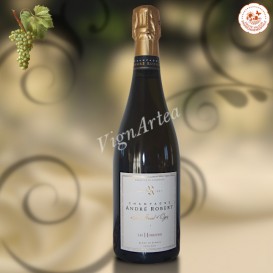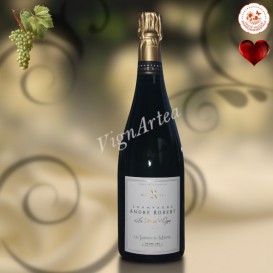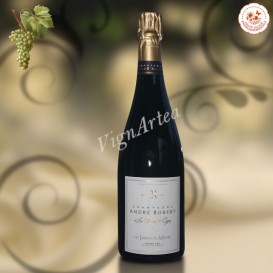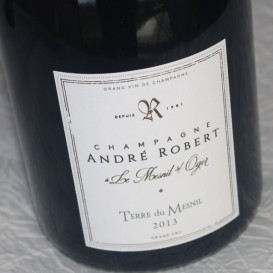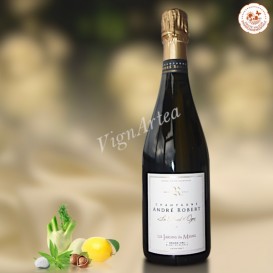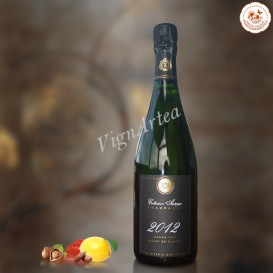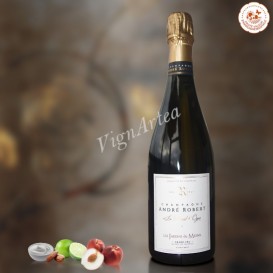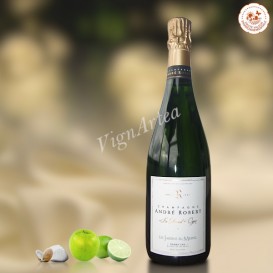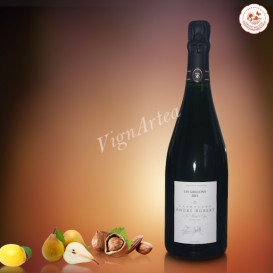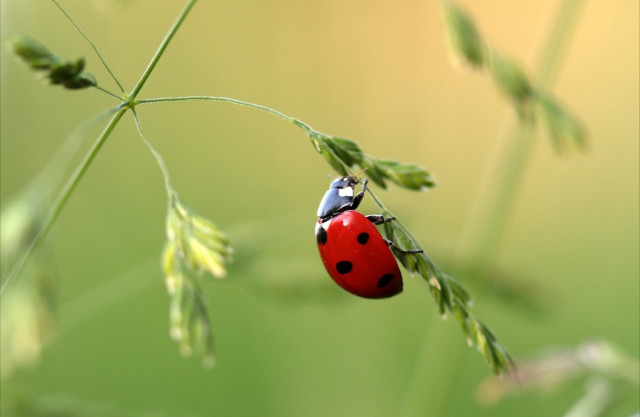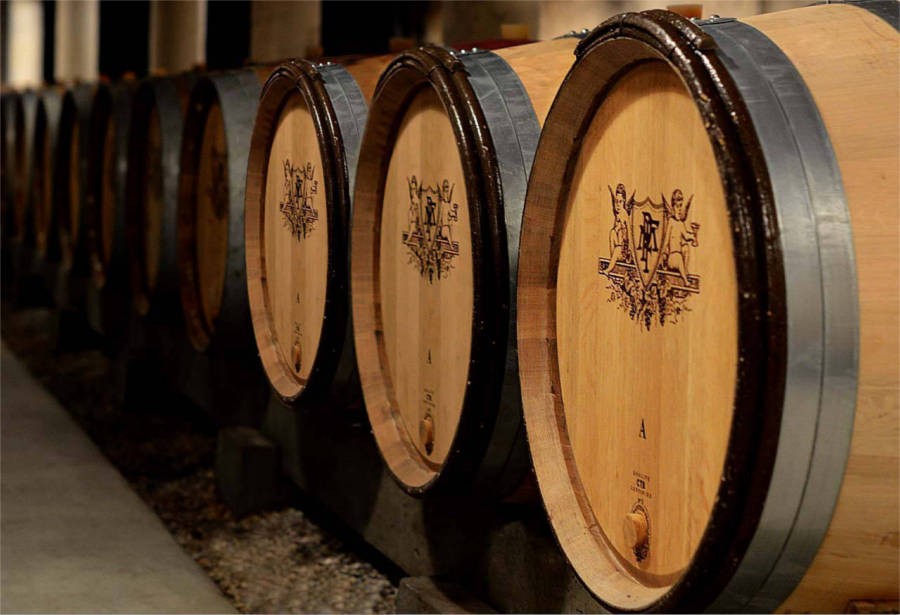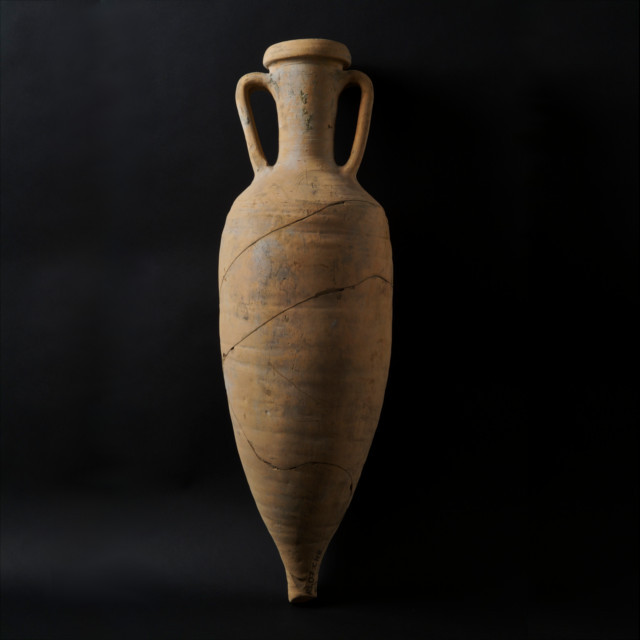Champagne André ROBERT

CHAMPAGNE CÔTE DES BLANCS 14 ha HVE WINEMAKER : Jean-Baptiste DENIZART
ESTATE HISTORY
The Champagne André ROBERT Estate is located in the Côte des Blancs region, on the classified Grand Cru village Le Mesnil sur Oger. Running the vineyard for five generations, the estate has 14 ha of parcels classified Grand Cru at Le Mesnil Oger and Premier Cru at Vertus, Etréchy and Cuis. It has got the status of harvester-makers (RM), which means that it grows vines, harvests, develops and sells its own champagne without buying grapes or wine. It also supplies the Billecart Salmon Estate with clear wines.
This domain is not very well-known, wrongly in our opinion, because it emanates from those champagnes a passion for meticulous work and a desire to higher quality every year.
The estate is currently run by Claire ROBERT and Jean-Baptiste DENIZART, both of them are committed to an environmentally friendly approach. In fact, they obtained the HVE (Haute Valeur Environnementale) level 3 label in 2018 : this certification attests to environmental excellence translated by the achievement of performance thresholds (performance requirements) in four areas : biodiversity (hedges, grassland, groves ...), phytosanitary strategy, fertilization management, and irrigation process.
From the domain's fragmented plots, Jean-Baptiste wants to extract the quintessence through a tailor-made vinification, where each detail counts. His motto is patience: the Grand Cru champagnes made from the parcels of Le Mesnil sur Oger are all matured 7 years on slats in the precious estate chalk cellar.
WINEGROWING & WINEMAKING
Only the cuvée, that is to say the first juice obtained by three successive presses, is used ; more rarely, and depending on the year, the taille, that is to say the second juice obtained by two additional presses, can be integrated.
The alcoholic fermentation starts spontaneously either with the native yeasts, or by the use of a leaven, elaborated from the must. Sometimes, the winemaker uses active dry yeasts but their use is increasingly rare, because it is noted that native yeasts are getting the upper hand. The wines do not carry out the malolactic fermentation : on the one hand, because the very low pH of the must is unfavorable to the lactic bacteria development. Only fine lees are kept into the must that is slightly sulphited to ensure microbial stability during the 7 months ageing in barrels.
The wines are then bottled for a second fermentation and rest on slats from 3 to 7 years depending on the vintage.
Then remains the sugar addition final process, called liqueur de dosage, to compensate the liquid loss caused by the bottle disgorging. This process is rarely mentioned in detail, yet it can have a significant impact on the final wine balance. Especially when the "liqueur de dosage" is homemade, as is the case for André ROBERT champagnes.
The use of Rectified Concentrated Must (RCM) obtained industrially from dehydrated must can simplify the sugar addition process because it is simple to use, very concentrated in sugars, odorless and the result is always the same. On the other hand, the RMC does not allow to play with the wine's evolution according its disgorging date ; that's why Jean-Baptiste wants to prepare his liqueurs himself and he has, to this purpose, a collection of reserve wines and wines of the year to bring the champagne its final touch. In order not to be mistaken about the result to obtain, he carries out tests of different sugar addition levels on a dozen bottles and he analyzes their evolution in time: at D-day, then D + 15, then D + 30, and so on, and this, in order to select the appropriate sugar addition rate that will bring the champagne the best balance.
It is undeniable, Jean-Baptiste has distinguished himself from others, his champagnes have his touch, and if we had to describe them in one word we would say : Finesse and Exaltation.
-
LES HORIZONS 2020 (Champagne André ROBERT)
42,00 € In stock!COTE DES BLANCS - AOP CHAMPAGNE - WHITE BLANC DE BLANCS CHAMPAGNE
Extra-Brut Sugar addition : 3 g/l
Slats ageing for 31 monthsCrystalline - Pur - Delicate
- Nose: mineral. Chalky notes opening onto aromas of praline and green apple.
- Palate: supple attack, good tension on the palate, without excess. Lovely lemony finish.
- Tasting date: December 2024.
- OUR OPINION: This champagne has a strong identity: mineral and almost crystalline, it surprises with its suppleness and delicate mouthfeel. It's a lovely discovery that will appeal to lovers of lively champagnes without excessive tension.
The exceptional bottle's weight (1.8kg) may result in higher shipping costs for the final shopping cart.
- Nose: mineral. Chalky notes opening onto aromas of praline and green apple.
-
LES JARDINS DU MESNIL GD CRU EXTRA-BRUT BASE 2020 (Champagne André ROBERT)
48,00 € In stock!COTE DES BLANCS - AOP CHAMPAGNE - WHITE BLANC DE BLANCS CHAMPAGNE
Grape variety: Chardonnay (100%)
Extra-Brut Grand Cru
Slats ageing for 3 years Sugar addition : 4 g/lDelicate - Savory - Floral
- Nose: delicate and fresh, with a floral structure. Notes of praline, white flowers and a hint of lemon.
- Palate: supple attack, fine bubbles. Savory, salivating and nicely balanced.
- Tasting date: January 2025.
- OUR OPINION: if the 2019 base wine expresses itself on the fruit, 2020 offers a more floral, delicate and suave profile. This champagne offers great finesse and will delight every palate.❤️ A guaranteed favorite! ❤️
- Nose: delicate and fresh, with a floral structure. Notes of praline, white flowers and a hint of lemon.
-
LES JARDINS DU MESNIL GD CRU EXTRA-BRUT BASE 2019 (Champagne André ROBERT)
48,00 € In stock!COTE DES BLANCS - AOP CHAMPAGNE - WHITE BLANC DE BLANCS CHAMPAGNE
Grape variety: Chardonnay (100%)
Extra-Brut Grand Cru
Slats ageing for 3 years Sugar addition : 3 g/lFresh- Fine - Nervous
- Nose: fresh and fruity. Notes of citrus, citron with a hint of blood orange and green apple.
- Palate: supple attack. Fine bubbles, fine, fragrant substance.
- Tasting date: January 2025.
- OUR OPINION: a very fine, delicate vintage with great finesse. 2019 is tighter on the palate than the 2016 and 2020 bases.
- Nose: fresh and fruity. Notes of citrus, citron with a hint of blood orange and green apple.
-
TERRE DU MESNIL 2013 GRAND CRU - D: 07/2021 (Champagne André ROBERT)
60,00 € In stock!CÔTE DES BLANCS - AOP CHAMPAGNE - BLANC DE BLANCS CHAMPAGNE
Grape variety: Chardonnay (100%)
Brut Grand Cru Sugar addition : 4,3 g/l
- Nose: praline, grilled hazelnut, lemon and truffle.
- Palate: frank and invigorating attack. Delicate bubbles. Nice finish on lime.
Tasting date: november 2021
OUR OPINION: very nice champagne that I consider as one of the most qualitative of the house. Its truffled aromas make it unique. This champagne is a champagne with a high cellar potential.
The exceptional bottle's weight (1.8kg) may result in higher shipping costs for the final shopping cart.
-
LES JARDINS DU MESNIL GD CRU EXTRA-BRUT BASE 2016 (Champagne André ROBERT)
39,99 € In stock!CÔTE DES BLANCS - AOP CHAMPAGNE - BLANC DE BLANCS CHAMPAGNE
Grape variety: Chardonnay (100%)
Extra-Brut Grand Cru
Slats ageing for 4 years Sugar addition : 4 g/l- Nose: brioche notes, fennel, verbena, hazelnut and lemon
- Palate: frank and tonic attack. The juice is fresh and thirst-quenching. Fine bubbles.
Tasting date: October 2021
OUR OPINION: Champagne of great finesse, very successful, elegant and delicately scented. Suitable for all palates.
The exceptional bottle's weight (1.8kg) may result in higher shipping costs for the final shopping cart.
Other bases available:
-
COLLECTION D'AUTEUR 2012 GRAND CRU (Champagne André ROBERT)
76,00 € OUT OF STOCK!OUT OF STOCK!CÔTE DES BLANCS - AOP CHAMPAGNE - BLANC DE BLANCS CHAMPAGNE
Grape variety: Chardonnay (100%)
Extra-Brut Grand Cru Sugar addition: 3 g/l
- Nose: hazelnuts, almonds, pink grapefruit and lemon.
- Palate: invigorating and delicious at the same time, very fragrant with a delicately praline finish
Tasting date: February 2021
OUR OPINION: high quality champagne of the estate, sapid and well balanced.
The exceptional bottle's weight (1.8kg) may result in higher shipping costs for the final shopping cart.
-
LES PARCELLES DU TERROIR GRAND CRU (Champagne André ROBERT)
40,90 € In stock!CÔTE DES BLANCS - AOP CHAMPAGNE - BLANC DE BLANCS CHAMPAGNE
Grape variety: Chardonnay (100%)
Extra-Brut Grand Cru Sugar addition: 4 g/l
- Nose: hint of cream, almonds, white peach and lime.
- Palate: tonic and lemony, tasty with a nice saline finish.
Tasting date: December 2020
OUR OPINION: a tonic and saline cuvée, pleasant to drink. Suitable for all palates.
The exceptional bottle's weight (1.8kg) may result in higher shipping costs for the final shopping cart.
-
LES JARDINS DU MESNIL GRAND CRU BRUT NATURE B- 2014 (Champagne André ROBERT)
41,99 € In stock!CÔTE DES BLANCS - AOP CHAMPAGNE - BLANC DE BLANCS CHAMPAGNE
Grape variety: Chardonnay (100%)
Brut Nature Grand Cru Sugar addition : 0 g/l
Mineral - Fresh - Tonic
- Nose: lime, green apple with a hint of brioche
- Palate: nice tension. Invigorating juice. Lemony and slightly saline finish
Tasting date: December 2020OUR OPINION: mineral champagne with great freshness, perfect for accompanying oysters!
The exceptional bottle's weight (1.8kg) may result in higher shipping costs for the final shopping cart.
- Nose: lime, green apple with a hint of brioche
-
LES GRILLONS 2011 (Champagne André ROBERT)
57,80 € In stock!VALLEE DE LA MARNE - AOP CHAMPAGNE - Blanc de Noir sparking wine
Extra Brut - Sugar addition : 4 g/l
The bubble is fine, the nose reveals aromas of toasted hazelnuts, leaven, lemon, pear, and a touch of frangipane. In the mouth, the juice is tonic, fresh and lemony with a touch of almond in the finish. It's fresh and subtle. Great success for this tensed yet tasty Blanc de Noir champagne !
(Tasting date : Oct. 2019)
The exceptional bottle's weight (1.8kg) may result in higher shipping costs for the final shopping cart.

